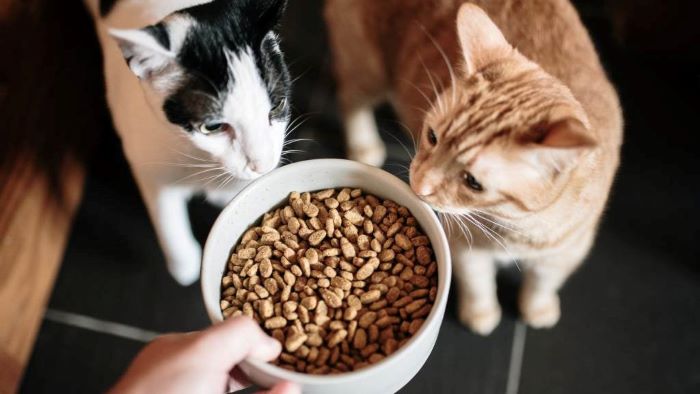A well-fed and well-nourished cat is a happy cat. Although the occasional mouse caught outside may supplement your cat’s diet, he will rely on you almost exclusively for his food. And that reliance places great responsibility on you.
Providing your cat with a healthy, balanced diet will help him to grow and develop as he should, and give him the best chance of living a long life, free of illness.
Essential Nutrition

Meat is the natural diet for cats. They eat meat because they cannot convert the fats and proteins found in vegetable matter into the amino acids and fatty acids necessary for their bodies to function properly and stay healthy. Meat protein contains everything they need plus an important amino acid that they cannot make—taurine.
Insufficient taurine in a cat’s diet can lead to blindness and heart disease. Taurine is added to all processed cat food. It is impaired by cooking, so if you cook your cat’s food yourself, you will also need to provide him with a regular taurine supplement.
Regardless of your own food preferences, you cannot turn your cat into a vegetarian without putting his health, and even his life, at risk. A feline digestive system is not designed to process large amounts of vegetable matter, although it is usual for cats to chew a little grass now and then.
Prey caught in the wild supplies not just meat protein but also essential fats, vitamins, minerals—such as calcium from bones—and fiber. Domestic cats are unlikely to have to hunt for their meals, and they are not natural scavengers, so they rely on us to supply the correct nutrients, whether in ready-made or home-cooked food.
Cats are notoriously picky eaters, so you may have to experiment with different types, textures, and flavors of food before you hit on the ones that bring your pet hurrying to his feed bowl.
Vitamins and Micronutrients
The vitamins needed for essential cat nutrition include D, K, E, B, and A (cats cannot manufacture vitamin A). They also need vitamin C, but intake of this vitamin should be monitored, as cats can develop bladder stones if they have too much.
Cats also require certain micronutrients—for example, phosphorus, selenium, and sodium. Although these are only needed in tiny quantities, a lack of them can lead to serious health problems.
A source of calcium is vital, too, as calcium only occurs in small quantities in meat. Most commercial cat food contains all of these essential vitamins and micronutrients.
Types of Food
Supermarket shelves offer a huge selection of prepared cat food in almost every gourmet flavor imaginable. So which ones should you choose? Most commercial cat foods are complete foods, that is, they provide all necessary nutrients and do not need anything else added.
However, some products may be labeled “complementary,” in which case they need to be combined with other foods to provide balanced nutrition. Check the information on the package to be sure which type you are buying.
Most prepared cat food is described as “dry” or “wet.” Dry food has been pressure cooked and then dried. In some cases, it is sprayed with fat to make it palatable, but this may require preservatives to be added.
Dry food usually includes antioxidants such as vitamin C and E, which are natural and beneficial to your cat. Although you should not give your cat dry food all the time, it does have some advantages. It can, for example, be left out during the day without spoiling.
You may want to give dry food in the morning and reserve the wet food for the evening. Wet food comes in airtight cans or pouches, so it does not need preservatives to keep it fresh. Although tasty, wet food is soft in texture, so it provides little resistance to keep teeth and gums healthy. If wet food is not eaten immediately, it will soon become unappealing to your cat.
Home-Cooked Food
For home-cooked meals, use meat and fish that is fit for human consumption. Make sure it is well cooked to kill bacteria or parasites.
Homemade meals are a good way of introducing cooked bones as a calcium source, but remove small, splintery bones and do not offer bones if your cat eats too quickly. The scraping action of bones keeps teeth in good shape; without them, your cat’s teeth will require regular cleaning.
Water
Your cat needs constant access to clean water, both indoors and outdoors, especially if his diet consists mostly of dry food. Water helps dilute the urine and is absorbed by fiber in the intestines.
Keep water bowls apart from the feeding bowls to avoid any contamination from scattered food. You need to change the water daily, and remember in particular to check that water bowls left in the yard are not full of debris.
Foods to Avoid
- Milk and cream can cause diarrhea, as most cats do not have the necessary enzymes to digest milk products. Special-formula “cat milk” is available.
- Onions, garlic, and chives cause gastric upsets and may lead to anemia.
- Grapes and raisins are thought to cause kidney damage.
- The alkaloid theobromine in chocolate is highly toxic to cats.
- Raw egg may contain the bacteria that causes food poisoning. Uncooked egg white disrupts vitamin B absorption, leading to skin problems.
- Raw meat and fish may contain harmful enzymes and also cause fatal bacterial poisoning.
- Small, splintery bones in cooked food can become lodged in the throat or farther down the digestive tract, causing blockage and tearing the intestinal lining.
When and How Much to Feed
Generally, your cat should be fed twice a day at regular times, usually once in the morning and once in the evening. This will allow him to build up an appetite and you to regulate how much he eats. Once you have established a regular feeding regime, it will be easy to tell if your cat has lost his appetite and is unwell.
The feeding levels for your cat may need to be increased or decreased depending on your cat showing signs of being under- or overweight. As a guideline, you should be able to feel your cat’s ribs easily but not see them (see panel, right).
Make sure you never feed an adult cat food intended for kittens or dogs—kitten food contains too much protein and will be bad for an adult cat’s kidneys; conversely, dog food does not contain enough protein for a cat. To prevent infections or health problems, make sure your cat’s food and water bowls are always washed thoroughly after use.
The Right Balance
Cats enjoy variety, and it is important that they are fed a mix of different foodstuffs to ensure they get adequate nutrition. Make any changes to your cat’s diet gradually, so that he can build up enough bacteria in his gut to digest the new food.
Once you’ve found a varied and balanced diet that your cat likes, stick to it. Constantly changing his food may encourage him to become a fussy eater. Cats can hold out for days until you give them what they want.
Life Changes
Cats have different nutritional needs at different times of life in terms of both type and quantity of food. Kittens need a high-protein diet to sustain their rapid development, and there are many commercial brands of food specially formulated for them.
In their first few months, kittens should be fed smaller amounts at more frequent intervals than adult cats; four to six tiny meals a day would be the average for a kitten that has just started on solids. Later, you can increase the portions and reduce the number of meals.
Initiate any new feeding regime in easy stages, because a rapid change can cause digestive upsets. To introduce a new foodstuff, replace 10 percent of the original food with the new food, increasing the proportion by 10 percent daily until your kitten is eating only the new food by the tenth day—this will prevent diarrhea.
If he does get an upset stomach, revert to a higher proportion of the old food and take longer to make the switch. Most adult cats in good health do well on two meals a day. However, as a cat ages, his appetite may diminish and you may need to revert to feeding him little and often again. The commercial cat food market caters to seniors just as it does to kittens.
A pregnant cat needs extra protein and vitamins, and will want to eat more in the final stages of pregnancy. This may mean giving her smaller portions more frequently if she cannot eat as much as usual in one meal. She will also have increased nutritional requirements when nursing.
A vet’s advice is essential when controlling a cat’s weight or if a special diet is required for a medical condition. You may also want to consult your vet on your cat’s diet during a pregnancy and while she is nursing.
Food allergies in cats are rare, but when they occur the only way to find the cause is through a food-elimination trial supervised by your vet.
An Ideal Weight
By checking your cat’s weight and girth regularly, you will soon recognize if he is getting fat or becoming too thin (see panel, opposite). If you have any concerns, take your cat to the vet to be weighed It is hard to refuse a cat who appears to be ready for a second helping, but overfeeding soon leads to obesity.
Being overweight is just as unhealthy for cats as it is for humans. Appetite is not necessarily linked to a high- energy lifestyle; many inactive cats are capable of packing away enormous meals. Indoor cats have the highest risk of obesity—some types are naturally sedentary and need encouragement to climb down from the sofa now and then.
Outdoor cats are more likely to burn up the energy they get from food. Packaged foods give some guidelines on how much to feed, but the amounts suggested are only approximate. If your pet is becoming rotund, even though you are careful with portion sizes, suspect him of scrounging meals elsewhere.
A conversation with the neighbors may solve the mystery. Weight loss without a change in diet should never be ignored, since it can be an early sign of illness. Very elderly cats do tend to become thinner with age, but you should ensure that there are no underlying problems such as loose teeth. Have your cat checked by the vet if he is refusing food or has difficulty chewing.
Giving Treats
Whether given as rewards in training or to aid bonding with your cat, try to ration treats to keep your cat from gaining weight.
Treats are largely unnecessary, but if you do give them make sure that they make up no more than 10 percent of your cat’s calorie intake and adjust meals accordingly. Some treats may give nutritional benefits, but others contain “filler” ingredients with little nutritional value and lots of fat.

